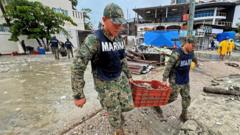As of Thursday, southern Mexico is actively engaged in organizational efforts to clean up after Hurricane Erick, which pummeled its Pacific coast. The storm initially made landfall as a formidable Category 3 but weakened to Category 1 after hitting the tourist hub of Puerto Escondido in Oaxaca state. The storm caused significant infrastructure damage; electricity and phone service was disrupted, and essential services in at least two hospitals were impacted. Flooded roads and damaged buildings compounded the difficulties faced by local residents.
Despite the destructive force of the storm, authorities confirmed that no fatalities or injuries had been documented. However, the US National Hurricane Center (NHC) issued warnings about potential flooding and enduring high winds as Erick pushed further inland. A "life-threatening" storm surge was anticipated, alongside warnings of towering waves reaching up to 10 meters (approximately 33 feet) post-storm.
Local army units have been redeployed to assist with the clean-up, with over 120,000 residents initially losing power. As of late morning, about a quarter of those affected regained electricity. Wind gusts in Oaxaca peaked at 125 mph (205 km/h) prior to a noticeable reduction to 85 mph.
In Acapulco, situated nearly 250 miles (400km) away, the port city was nearly abandoned as residents followed safety advisories. Local shops were boarded up, and many people prepared by securing food and gasoline in advance of the storm's arrival.
Alerts for potential flooding and mudslides remained active for Oaxaca and neighboring Guerrero, along with ongoing alerts for dangerous storm surges on the coastline. Although the NHC reported a swift dissipation of Erick’s intensity, officials continued to urge caution.
President Claudia Sheinbaum emphasized safety, particularly for residents in low-lying or river-adjacent areas, recommending they seek shelter in one of over 2,000 preemptively established sites across Chiapas, Guerrero, and Oaxaca. This storm follows the devastation caused by Hurricane Otis earlier in 2023, highlighting the regions' vulnerability to severe weather events.
Residents affected by Hurricane Erick are encouraged to share their experiences, with multiple contact methods provided for outreach.






















